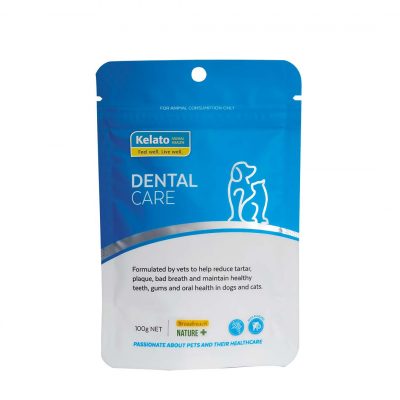Could you get through the day feeling good if you never brushed your teeth? If your dog or cat’s breath isn’t pleasant, or the gums are bright red anywhere, or the teeth are discoloured with a build-up, your pet probably has gingivitis or periodontal disease.
Dental disease isn’t always obvious, what you see when your dog smiles is just the tips of the teeth. You need to take a close look at the margin between the gums and the teeth.

What to look for:
• Bad breath
• Red line around the gums
• Tartar and calculus build up
• Broken teeth
• Worn teeth
• Eating on one side
• Hates having mouth touched
• Difficulty eating
What Is Gingivitis and Periodontal Disease?
Initially, gingivitis is simply an inflammation of the gums caused by bacteria, food particles or hair trapped under the gum. Periodontal disease is when the ligaments that hold the teeth in place become diseased. It is caused by worsening gingivitis and the accumulation of plaque (and plaque bacteria) on the teeth and surrounding structures. It progresses steadily and may become incurable. Plaque accumulates due to poor oral hygiene but can be made worse if your pet has another disease or their immunity is compromised.
There are at least 200 different bacteria associated with plaque – some are harmless but others can destroy tissue, produce harmful substances, and can damage the bone and teeth. Reports suggest an association between the presence of periodontal disease and illnesses that affect the lungs, kidneys and heart. Moderate to severe cases of periodontal disease may result in bacteria entering the bloodstream.
Calculus, the hard brown stuff on teeth, forms when plaque is mineralised with calcium salts from saliva. It doesn’t cause any harm in itself. However, it provides a rough surface for bacteria to accumulate around. Preventing periodontal disease requires removing existing plaque and calculus and avoiding further accumulation.
If your pet has fractured teeth, infected teeth or broken tips especially on the canines, dentistry is needed. Some teeth can be kept if root canals are performed, but sometimes the teeth just have to come out, otherwise they are a chronic source of pain and infection that will ultimately compromise your pet’s health.
Prevention Begins at Home
Hard, fibrous foods are more effective than sticky, soft diets (such as fresh meat or canned food) at preventing the accumulation of dental deposits and gingivitis. To increase the hardness of the diet, consider adding raw meaty bones and fresh vegetables and fruit – such as celery, apples, carrots and cauliflower. Your veterinarian can advise the safest bones or chews to use.
Biscuits and chews that are specifically designed to help clean teeth can also be useful. Not all dry foods are equally effective at reducing plaque build-up, and not all soft diets will have the same effect on its accumulation.

What You Can Do To Support Dental Care
Check your pet’s teeth and gums on a regular basis. Have them checked by your vet at every visit. And have them cleaned, extracted, repaired if necessary before implementing the following changes. Starting with clean teeth will make your job much easier.



Provide raw meaty bones early in life, and on a regular basis for both cats and dogs. Very hard biscuits, special dental diets, dental ropes and other types of chews should be considered. The abrasive effect of gnawing will help to strengthen the periodontal ligaments of the teeth.
Tooth brushing needs to be done daily to be effective. Animals with crowded teeth or very long hair should begin having their teeth brushed as puppies or kittens. They are prone to periodontal disease especially in the front teeth, due to hair and food getting caught between the teeth. Pet toothbrushes and toothpastes are available. Baby toothbrushes can also be useful.

Oral cleansing gels containing zinc, vitamin C and sulphur amino acids can be used daily and are easy to apply as they are wiped on the gums instead of brushing. Your veterinarian can advise the best ones for your pet.
How Your Vet Can Help
A veterinary dental scale and polish can be carried out at most vet practices. There are veterinarians who also specialise in veterinary dentistry if you want a referral. Dental scaling requires sedation or anaesthesia to be carried out correctly. Simply cracking off brown calculus is not enough – the space underneath the gum and between the teeth and gums needs to be cleaned too. After teeth have been cleaned, they can be kept clean by following some of the suggestions above. If your pet has severe periodontal disease, some teeth may need to be removed and more treatments may be necessary to prevent progression of the disease. Talk to your vet about your pet’s dental care and oral health options.
How Supplements Can Help
Supplements are available that specifically target plaque build-up. These can help improve oral health. There are advanced supplements available that can help support healthy gums and teeth by reducing plaque, supporting good bacteria in the mouth and the structures that support the teeth. These are a great way to help promote healthy oral hygiene.
Kelato Animal Health’s Dental Care is a great, easy to use option that is suitable for both cats and dogs. Helping support your pet’s dental health, Dental Care helps to reduce tartar; plaque and bad breath; promotes healthy saliva and oral health; and supports healthy teeth and gums.
Dental Care can simply be mixed into your pet’s daily food to:
- Help to reduce tartar, plaque, and bad breath
- Promote healthy saliva and oral health
- Support healthy teeth and gums
- Promote fresh breath
Want to find out more? Head to the Dental Care page or get in touch on 1800 KELATO or email our team at petcare@kelato.com.au.





